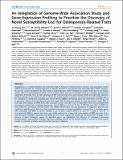An Integration of Genome-Wide Association Study and Gene Expression Profiling to Prioritize the Discovery of Novel Susceptibility Loci for Osteoporosis-Related Traits

View/
Author
Zillikens, M. Carola
Farber, Charles R.
Demissie, Serkalem
Soranzo, Nicole
Bianchi, Estelle N.
Grundberg, Elin
Estrada, Karol
Zhou, Yanhua
van Nas, Atila
Moffatt, Miriam F.
Zhai, Guangju
van Meurs, Joyce B.
Pols, Huibert A. P.
Price, Roger I.
Nilsson, Olle
Pastinen, Tomi
Cupples, L. Adrienne
Lusis, Aldons J.
Schadt, Eric E.
Ferrari, Serge
Uitterlinden, André G.
Rivadeneira, Fernando
Spector, Timothy D.
Wilson, Scott G.
Richards, J. Brent
Note: Order does not necessarily reflect citation order of authors.
Published Version
https://doi.org/10.1371/journal.pgen.1000977Metadata
Show full item recordCitation
Hsu, Yi-Hsiang, M. Carola Zillikens, Scott G. Wilson, Charles R. Farber, Serkalem Demissie, Nicole Soranzo, Estelle N. Bianchi, et al. 2010. An integration of genome-wide association study and gene expression profiling to prioritize the discovery of novel susceptibility loci for osteoporosis-related traits. PLoS Genetics 6(6): e1000977.Abstract
Osteoporosis is a complex disorder and commonly leads to fractures in elderly persons. Genome-wide association studies(GWAS) have become an unbiased approach to identify variations in the genome that potentially affect health. However,
the genetic variants identified so far only explain a small proportion of the heritability for complex traits. Due to the modest
genetic effect size and inadequate power, true association signals may not be revealed based on a stringent genome-wide
significance threshold. Here, we take advantage of SNP and transcript arrays and integrate GWAS and expression signature
profiling relevant to the skeletal system in cellular and animal models to prioritize the discovery of novel candidate genes
for osteoporosis-related traits, including bone mineral density (BMD) at the lumbar spine (LS) and femoral neck (FN), as well
as geometric indices of the hip (femoral neck-shaft angle, NSA; femoral neck length, NL; and narrow-neck width, NW). A
two-stage meta-analysis of GWAS from 7,633 Caucasian women and 3,657 men, revealed three novel loci associated with
osteoporosis-related traits, including chromosome 1p13.2 (RAP1A, p = 3.661028), 2q11.2 (TBC1D8), and 18q11.2 (OSBPL1A),
and confirmed a previously reported region near TNFRSF11B/OPG gene. We also prioritized 16 suggestive genome-wide
significant candidate genes based on their potential involvement in skeletal metabolism. Among them, 3 candidate genes
were associated with BMD in women. Notably, 2 out of these 3 genes (GPR177, p = 2.6610213; SOX6, p = 6.4610210)
associated with BMD in women have been successfully replicated in a large-scale meta-analysis of BMD, but none of the
non-prioritized candidates (associated with BMD) did. Our results support the concept of our prioritization strategy. In the
absence of direct biological support for identified genes, we highlighted the efficiency of subsequent functional
characterization using publicly available expression profiling relevant to the skeletal system in cellular or whole animal
models to prioritize candidate genes for further functional validation.
Terms of Use
This article is made available under the terms and conditions applicable to Other Posted Material, as set forth at http://nrs.harvard.edu/urn-3:HUL.InstRepos:dash.current.terms-of-use#LAACitable link to this page
http://nrs.harvard.edu/urn-3:HUL.InstRepos:4881567
Collections
- HMS Scholarly Articles [17920]
- SPH Scholarly Articles [6362]
Contact administrator regarding this item (to report mistakes or request changes)


